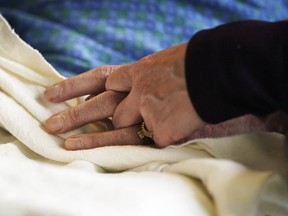Fifteen times as many Canadians as Californians are choosing an assisted death. A study suggests one in 10 deaths in Canada will be by MAID
Article content
As a Calgary father’s legal battle to block his autistic daughter’s assisted death ignites debate over whether Canada’s euthanasia regime is expanding beyond what Canadians may be comfortable with, a new study suggests MAID deaths in Canada could continue to expand for another decade, until one in 10 deaths involve a doctor-administered lethal injection.
Advertisement 2
Article content
The predictions are based on a new paper exploring the dramatically higher number of people in Canada choosing an assisted death compared to Californians. Both Canada and California granted access to medical assistance in dying, or MAID, in 2016.
Article content
Both have similarly sized populations, similar, though not identical, demographics, and no real differences in the leading causes of death or overall death rates.
However, 853 Californians died by MAID in 2022, compared to 13,241 in Canada.
Recommended from Editorial
In 2022, MAID accounted for 4.1 per cent of all deaths in Canada, compared to 0.27 per cent of all deaths in California.
In the Netherlands and Belgium, which legalized assisted dying 22 years ago, 5.1 per cent of Dutch citizens and 2.5 per cent of Belgians die by MAID. While Canada’s overall rate remains lower than those two nations, British Columbia and Quebec have rates, respectively, of 5.5 per cent and 6.6 per cent, outpacing the assisted-suicide pioneers.
Article content
Advertisement 3
Article content
The authors of the new study suggest that if there is an upper limit in euthanasia deaths it is not going to max out at five per cent of all deaths.
At this point, the study suggests, 25 per cent of Canadians would choose MAID if they faced a long and painful death from a disease like cancer. This suggests that Canada’s upper limit on MAID deaths could be 10.5 per cent of all annual deaths.
In the new study, researchers tested 10 hypotheses that might explain the 15-fold difference in MAID deaths between Canada and California — what factors might be driving Canada’s strikingly higher MAID uptake, “or, conversely, preventing Californians from taking advantage of a legal route towards relieving unnecessary suffering,” said co-author Peter Reiner, professor emeritus of neuroscience and neuroethics at the University of British Columbia.
Reiner and his co-author, Adrian Byram, who is a member of the advocacy group End of Life Choices California, surveyed 556 adults (228 each in California and Canada) aged 60 and older — the age group that accounts for most MAID requests.
Advertisement 4
Article content
Only 25 per cent of Californians said they were aware that MAID was legally available as an option if they had a terminal illness such as advanced cancer, compared to 67 per cent of Canadians who were aware “that MAID was an option were such a calamity to befall them,” Reiner said in an email to the National Post.
The data “represent rather strong evidence” that greater public awareness of MAID is an important, if not the driving factor, behind the differing rates of assisted suicide, Reinder said.
Other “stand-out” factors included the number of MAID practitioners in Canada and higher “institutional support.” Canada has six times the number of MAID practitioners per capita — 5.2 practitioners per 100,000 people versus 0.87 per 100,000 in California.
“In Canada, every provincial and regional public health authority in Canada makes accessing MAID straightforward,” the authors wrote.
Information is readily available on websites, and almost all provide staff to help patients navigate the process. No such assistance exists in California, they said.
The researchers, though, found no differences in the moral acceptance of MAID. Two-thirds or more of both Canadians and Californians felt MAID was morally acceptable. The difference in the mode of death also didn’t seem to be a factor. Californians are required to self-ingest a doctor-prescribed lethal dose of drugs. Canadians, outside Quebec, can choose either the oral route, which is rarely used, or injection by a doctor or nurse practitioner.
Advertisement 5
Article content
Canada recently expanded access to MAID by removing the requirement for a “reasonably foreseeable death,” such as a diagnosis of terminal cancer. Now, Canadians can receive MAID for a “grievous and irremediable” condition, even when natural death isn’t imminent.
But the authors said that doesn’t account for the discrepancy, since 96.5 per cent of MAID procedures in Canada in 2022 still relied upon the reasonably foreseeable death criterion.
However, in Canada, there is no specific time limit.
California requires that death be expected within six months.
Critics have suggested that lax oversight could be contributing to a higher rate of MAID deaths in Canada. But the authors said Canada has more explicit punishment for failure to comply with safeguards or reporting standards than California.
“California is silent on the matter,” Reiner said.
In the Calgary case now before the courts, the father of a 27-year-old woman approved for MAID argues his daughter has been misdiagnosed with physical ailments that are psychological, and therefore ineligible under current law.
Advertisement 6
Article content
Trudo Lemmens, a University of Toronto professor of law and ethics, has argued that MAID is being promoted as a form of therapy, “even for only remotely disease-related suffering.”
“Canadian patients are much more frequently confronted with offers of MAID and with a physician providing it as a form of care,” Lemmens said in an email.
Yet Lemmens is also not convinced, based on a small survey study, that “it’s all about public awareness,” because Canada’s rate of MAID deaths is higher than in jurisdictions with greater public awareness, as it has been an option for decades.
If Canada’s MAID deaths grow to one in 10 deaths, Canada will have “failed miserably to protect the vulnerable,” said Daryl Pullman, a professor of bioethics at Memorial University.
“Death is now ‘therapy’ in Canada and the MAID regime is the most efficient part of the Canadian healthcare system,” Pullman said. “Far from celebrating this, as these authors appear to do, we should be revisiting how we got things so terribly wrong in this space and what needs to be done to fix it.”
National Post
Our website is the place for the latest breaking news, exclusive scoops, longreads and provocative commentary. Please bookmark nationalpost.com and sign up for our daily newsletter, Posted, here.
Article content








